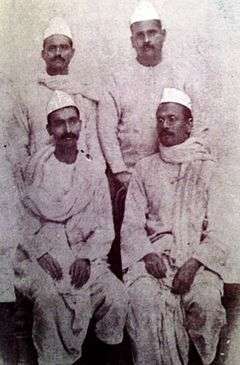Raj Kumar Shukla
| Raj Kumar Shukla | |
|---|---|
| Born |
23 August 1875 Satwaria, Champaran, Bihar |
| Died |
20 May 1929 Motihari, Bihar |
| Occupation | Freedom fighter, Farmer |
| Language | Hindi, Bhojpuri, Kaithi, Maithili, |
| Nationality | Indian |
| Period | 1890s - 1920s |
| Children | Ramsunder Kunwar, Devpati kunwar (Daughters) |
| Relatives | Saryu Rai, Asharfi maharaj (Son-in-Laws), Mani Bhushan Rai, Shashi Bhushan Rai, Ravi Bhushan Rai (grandchildren) |
Raj Kumar Shukla was the person who convinced Mr. M.K.Gandhi to visit Champaran. He was born in 1875 at Satwaria सतवरिया village, in Champaran, where his Bhatt Brahman ancestors lived for 200 years. Mr. Shukla stated himself about this in front of Champaran agrarian committee. His another village was Murli Bharahwa (मुरली भरहवा) in Champaran itself. In Murli Bharahwa he has acres of farming land. His father's name was Kolahal Shukla . He was a villager from India who became famous for his association with Mahatma Gandhi during Champaran Satyagrah.[1] Raj Kumar Shukla was instrumental in inviting Gandhi to Champaran village in Bihar and this struggle was a turning point in India's fight for independence.
History
During the 31st session of the Congress in Lucknow in 1916, Gandhiji met Raj Kumar Shukla, a representative of farmers from Champaran, who requested him to come and see for himself the miseries of the indigo ryots (tenant farmers) there. Gandhi later wrote in his autobiography “I must confess that I did not then know even the name, much less the geographical position, of Champaran, and I had hardly any notion of indigo plantations.” " [2] Now we can say that Raj Kumar Shukla met Mahatma Gandhi to make him aware of the plight of the cultivators in Champaran and persuaded him to go there. He was known Indigo cultivator of the area as he was a money lender from village Murli Bharahwa near Narkatiaganj in West Champaran, earning, according to his own statement before the enquiry committee set up by the provincial government, a sum of two thousand rupees a month from interest [3][4] Bhatt Brahmins in Champaran had earlier revolted against indigo cultivation in 1914 (at Pipra) and 1916 (Turkaulia).
Honour

To commemorate his 125th birth anniversary, the Department of Posts released a stamp in his honour in 2000.[5] after Gandhi's assassination it was first time that Govt. recognise his contributions towards Indian Independence.
On the occasion of 100 years of Champaran Satyagrah Govt. of Bihar established a Statue of Pt. Rajkumar Shukla at Gandhi Sangrhalay (गांधी संग्रहालय) Patna and Gandhi Peace Foundation Delhi has showcased Photograph of Raj Kumar Shukla
Books on Raj Kumar Shukla
On the occasion of 100 years of Champaran Satyagrah noted writer Arvind Mohan written a Book on him and his other supporters named Champaran : Satyagrah Ke Sahyogi. (चंपारण :सत्याग्रह के सहयोगी). The book released by Chief Minister of Bihar Nitish Kumar on 10 April 2017. In September 2017 noted writer Arvind Mohan written a book named Mr. M.K. Gandhi ki Champaran Diary. In this book Raj Kumar Shukla emerged as main contributor of Mahatma Gandhi's Satyagrah.
Another book written by B.L.Das. This book based on Raj Kumar Shukla's diary गांधी जी के चम्पारण आंदोलन के सूत्रधार राजकुमार शुक्ल की डायरी. Latest book written by Dr. Sujata Chaudhary, सौ साल पहले (चम्पारण का गांधी)
Gandhi in Champaran

Mahatama Gandhi arrived in Champaran with his team of eminent nationalists Rajendra Prasad, Anugrah Narayan Sinha, Brajkishore Prasad and the Champaran Satyagraha began.[6]
See also
References
- ↑ A struggle for freedom
- ↑
- ↑ Tidrick, Kathryn (2006). Gandhi: A Political and Spiritual Life. I.B.Tauris. p. 117. ISBN 978-1-84511-166-3. Retrieved 2008-10-06.
- ↑ "West Chaparan District at a Glance". Tirhut Division. Retrieved 2008-10-06.
- ↑ http://www.maharashtrapost.gov.in/htmldocs/oct2000.htm
- ↑ Brown, Judith Margaret (1972). Gandhi's Rise to Power, Indian Politics 1915-1922: Indian Politics 1915-1922. New Delhi: Cambridge University Press Archive. p. 384. ISBN 978-0-521-09873-1.